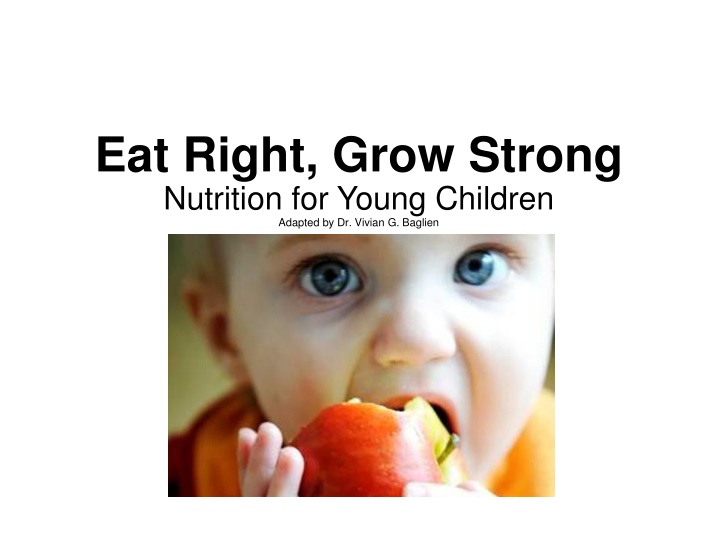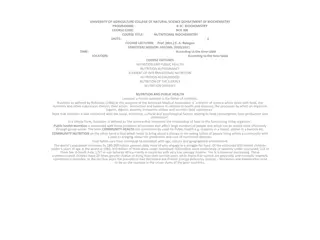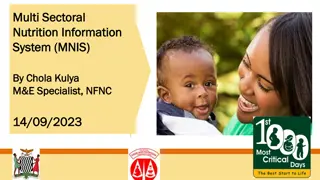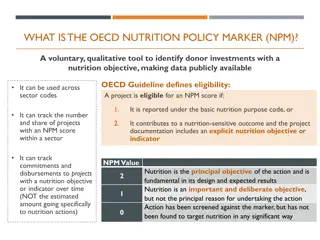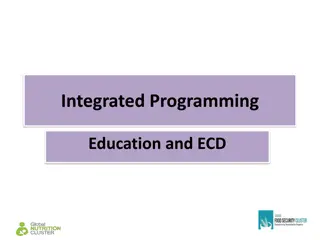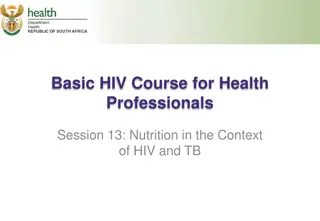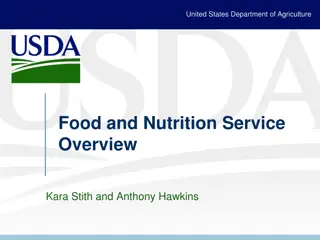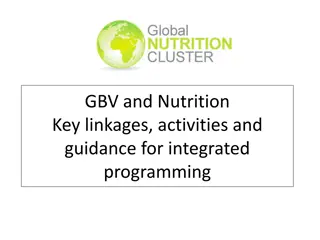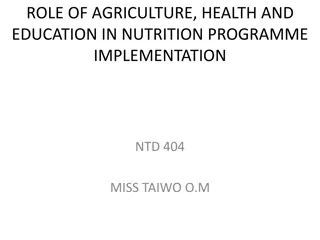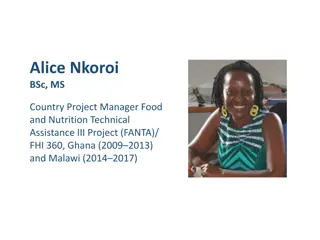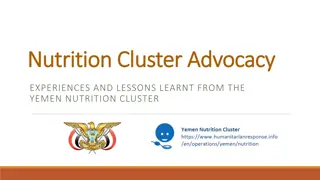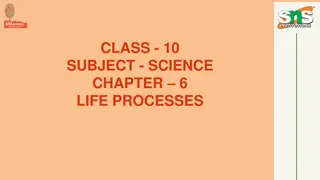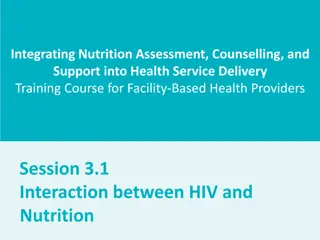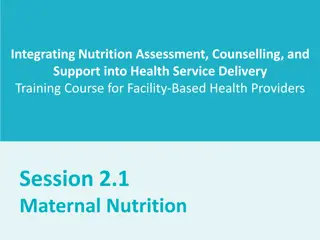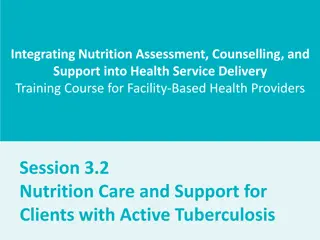Importance of Good Nutrition for Young Children
Providing good nutrition to young children is crucial as it supports their rapid growth and development. More than 1 in 4 preschoolers are overweight or obese, emphasizing the need for healthy eating habits. Child care providers and parents play a key role in shaping children's dietary choices and can influence positive changes in food environments. Encouraging the consumption of fruits and vegetables in creative ways can make healthy eating enjoyable for children.
Download Presentation

Please find below an Image/Link to download the presentation.
The content on the website is provided AS IS for your information and personal use only. It may not be sold, licensed, or shared on other websites without obtaining consent from the author.If you encounter any issues during the download, it is possible that the publisher has removed the file from their server.
You are allowed to download the files provided on this website for personal or commercial use, subject to the condition that they are used lawfully. All files are the property of their respective owners.
The content on the website is provided AS IS for your information and personal use only. It may not be sold, licensed, or shared on other websites without obtaining consent from the author.
E N D
Presentation Transcript
Eat Right, Grow Strong Nutrition for Young Children Adapted by Dr. Vivian G. Baglien
Objective Describe why good nutrition is so important to young children.
Basic Facts About Nutrition & Young Children More than 1 in 4 preschoolers are overweight or obese Being overweight is a risk to physical and mental health Poor nutrition contributes to weight gain Child care providers can help keep children healthy
Nutrition Young children need to eat nutritious foods because their bodies are growing rapidly. Children may receive between 50% and 75% of their daily calories at the child care facility. Children learn healthy (or unhealthy) eating habits at a very young age.
What does all this mean for Child Care Providers & Parents? Providers & parents have an important influence on children s eating habits: The development of early eating habits and attitudes Children look up to their teachers and often model their own eating habits based on watching others. Providers & parents can make changes to create a better food environment so it s easier for children and staff to make healthier choices.
Nutrition Activity Child care providers & parents are role models for healthy eating. How can you be a good role model for the children?
Fruits and Vegetables A variety of fruits and vegetables give children vitamins and minerals that keep them healthy and help them grow. Fruits and vegetables are nutrient dense lots of nutrients but few calories, unless too much butter, cheese, or meat fat is added. 100% fruit and vegetable juices are good but less nutritious and filling than the foods themselves.
Make eating fruits and vegetables fun! Ways to get kids to LOVE their fruits and vegetables (or at least try them!) Serve them creatively. Have a party for your senses. Incorporate them into lessons by trying fruits and vegetables from different places around the world. Set a good example.
Meats and Fats Most sausage, bacon, and hot dogs have a lot of fat, sodium, and calories, so consuming too much can lead to future health problems. Look for lower fat baked options and serve the high fat versions less often. French fries and chicken nuggets are also high in saturated fat and calories. Kids will also enjoy lower fat foods like baked potatoes and baked chicken. Consider occasionally replacing meat with beans for a low fat option with lots of fiber and protein.
Grains and Sugars Fiber aids digestion and helps children feel full. Try and incorporate high-fiber whole grain foods at least once every day. Sugary and salty foods have a lot of empty calories they are often high in fat and calories but have little nutritional value. Serve these only occasionally. No added sugars in infant foods or beverages.
Discussion How would you makeover these breakfast and snack items to incorporate whole grains? Muffins Frosted flakes Breakfast cereal bar Cookies Poptart Chips
Beverages Water is the best choice for thirsty children. Model good habits for the children by choosing water first. Soda and fruit drinks are full of sugar and empty calories (few nutrients, many calories). Serving low fat milk with meals and snacks provides calcium but doesn t add many calories.
Beverage Myths Myth 1: Whole milk is best for all kids Under 1: breast milk or formula 1 to 2: Whole milk ; continue breastmilk at parent request Over 2: 1% or skim milk
Beverage Myths Myth 2: Juice is always the best option Whole fruits have more nutrients Under 6: 4-6 oz. a day of 100% juice No juice for infants under 6 months; less than 4 oz/day from 6-12 months in cup only Not a good choice to quench thirst
Menus and Variety Serving a variety of foods helps to meet a child s nutrition needs. Children may need to see a new food at least 10 times before they ll actually try it. Don t give up! Including food in your menus from a variety of cultures can make meals more fun and interesting for children.
Feeding Practices Gently encourage, but don t force children to try a bite of a new food. Forcing children to clean their plates can lead to overeating and weight problems. Offer healthy foods to children and then let them decide if and how much to eat.
Feeding Practices Make meal and snack time as stress free as possible and try to provide enough time to eat. Try to avoid using food to reward good behavior or make a child feel better about something.
Foods Offered Outside of Regular Meals and Snacks Celebrate birthdays, and holidays with healthier options than candy, cake, and ice cream. Healthier sweets like fruit, popsicles, and low-fat muffins are great alternatives.
Supporting Healthy Eating If possible, serve meals family-style where teachers join the children at the table. Teachers can show that healthy eating is fun by modeling healthy choices and helping to create a pleasant social environment around the table. Soda machines in your facility send the message that soda is OK, and make it harder for staff and children to choose healthier options
Things to Remember Children will eat! They are capable of regulating their food intake. They generally react negatively to new foods, but will usually accept them with time and experience. Caregivers can either support or disrupt children s food acceptance and regulation.
Nutrition education activities for children Preschoolers can cook and learn!! What they can do What they can learn Measure, stir, beat Fine motor skills Peel, cut, grate Follow directions Hot vs. cold Observing Compare quantities Enhance social skills Set the table Sorting, classifying skills
How to Make a Healthy Lunch What is the difference? Unhealthy Healthy Chicken nuggets Baked, skinless chicken breast Tator tots Steamed carrots Canned fruit cocktail in heavy syrup Fresh strawberries Slice of white bread Whole wheat dinner roll Whole milk Skim milk
